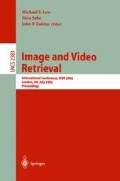Abstract
In this paper, an online Bayesian formulation is presented to detect and describe the most significant key-frames and shot boundaries of a video sequence. Visual information is encoded in terms of a reduced number of degrees of freedom in order to provide robustness to noise, gradual transitions, flashes, camera motion and illumination changes. We present an online algorithm where images are classified according to their appearance contents-pixel values plus shape information- in order to obtain a structured representation from sequential information. This structured representation is presented on a grid where nodes correspond to the location of the representative image for each cluster. Since the estimation process takes simultaneously into account clustering and nodes’ locations in the representation space, key-frames are placed considering visual similarities among neighbors. This fact not only provides a powerful tool for video navigation but also offers an organization for posterior higher-level analysis such as identifying pieces of news, interviews, etc.
This work was supported by CICYT grant TEL99-1206-C02-02 and CERTAP Generalitat de Catalunya.
Access this chapter
Tax calculation will be finalised at checkout
Purchases are for personal use only
Preview
Unable to display preview. Download preview PDF.
References
F. Arman, A. Hsu, and M.-Y. Chiu. Feature management for large video databases. In Storage and Retrieval for Image and Video Databases (SPIE), pages 2–12, 1993.
F. Arman, A. Hsu, and M.-Y. Chiu. Image processing on compressed data for large video databases. In Computer Graphics (Multimedia’ 93 Proceedings), pages 267–272. Addison-Wesley, 1993.
J. Corridoni and A. D. Bimbo. Structured representation and automatic indexing of movie information contents. Pattern Recognition, 31:2027–2045, 1998.
A. Dempster, N. Lair, and D. Rubin. Maximum likelihood from incomplete data via the EM algorithm. Journal of the Royal Statistical Society Series B, 39:1–38, 1977.
Y. Gong and X. Liu. Generating optimal video summaries. In IEEE International Conference on Multimedia and Expo (III), pages 1559–1562, 2000.
G. E. Hinton, P. Dayan, and M. Revow. Modeling the manifolds of images of handwritten digits. IEEE trans. on Neural Networks, 8(1):65–74, 1997.
J. Kivinen and M. Warmuth. Additive versus exponentiated gradient updates for linear prediction. Journal of Information and Computation, 132:1–64, 1997.
B. Moghaddam and A. Pentland. Probabilistic visual learning for object representation. IEEE Transactions on Pattern Analysis and Machine Intelligence, 19(7):696–710, 1997.
R. Neal and G. Hinton. A new view of the EM algorithm that justifies incremental and other variants. Kluwer, 1998.
M. Smith and M. Christel. Automating video database indexing and retrieval. ACM Int. Conf. on Multimedia, pages 357–358, 1995.
K. Sung and T. Poggio. Example-based learning for view-based human face detection. A.I. Memo 1521, C.B.C.L. Paper 112, 1994.
M. Turk and A. Pentland. Eigenfaces for recognition. Journal of Cognitive Neuroscience, 3(1):71–86, 1991.
H. Yu and W. Wolf. A visual search system for video and image databases. Int. Conf. on Multimedia Computing and Systems, pages 517–524, 1997.
R. Zabih, J. Miller, and K. Mai. A feature-based algorithm for detecting and classifying scene breaks, 1995.
H. Zhang, A. Kankanhalli, and S. Smoliar. Automatic partitioning of video. Multimedia Systems, 1:10–28, 1993.
W. Zhao, J. Wang, D. Bhat, K. Sakiewicz, N. Nandhakumar, and W. Chang. Improving color based video shot detection. In ICMCS, Vol. 2, pages 752–756, 1999.
Author information
Authors and Affiliations
Editor information
Editors and Affiliations
Rights and permissions
Copyright information
© 2002 Springer-Verlag Berlin Heidelberg
About this paper
Cite this paper
Orriols, X., Binefa, X. (2002). Online Bayesian Video Summarization and Linking. In: Lew, M.S., Sebe, N., Eakins, J.P. (eds) Image and Video Retrieval. CIVR 2002. Lecture Notes in Computer Science, vol 2383. Springer, Berlin, Heidelberg. https://doi.org/10.1007/3-540-45479-9_36
Download citation
DOI: https://doi.org/10.1007/3-540-45479-9_36
Published:
Publisher Name: Springer, Berlin, Heidelberg
Print ISBN: 978-3-540-43899-1
Online ISBN: 978-3-540-45479-3
eBook Packages: Springer Book Archive

